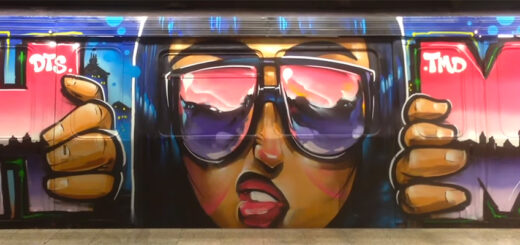Women Rule the Streets: The Surging Power of Female Graffiti Artists
When I think of graffiti, the vibrant sprawl of colors and the bold statements splashed across city walls instantly come to mind. But there’s a narrative often overlooked in this art form’s male-dominated scene: the rise of female graffiti artists. They’re not just part of the landscape; they’re reshaping it with every spray.
I’ve always been intrigued by the way these women wield their cans, turning public spaces into canvases that challenge societal norms. They’re not just adding beauty to the urban environment; they’re creating a dialogue, a visual conversation that’s impossible to ignore.
Their work isn’t merely about aesthetics; it’s a powerful form of self-expression and activism. From the streets of New York to the alleyways of Berlin, female graffiti artists are making their mark and I’m here to dive into their stories.
The Rise of Female Graffiti Artists
As I explore the evolution of graffiti, it’s evident that female artists have been emerging from the shadows to claim their space in the street art scene. The rise of female graffiti artists isn’t just a trend; it’s a movement. With spray cans and stencils in hand, these women are leaving indelible marks on the canvas of our cities. Their work is not only visually striking but also laden with messages that push the boundaries of social commentary.
In major cities across the globe, the influx of female graffiti artists is noticeable. They’re taking to the streets, armed with vibrant palettes and unique styles that distinguish their work from their male counterparts. What’s more, their presence is disrupting the once male-dominated field, creating a fresh discourse on gender roles within the art world.
- Artist collectives around the world are becoming more inclusive, championing the works of female artists.
- Exhibitions and galleries are dedicating space to highlight the contributions of women in graffiti.
- Social media has become a powerful tool for these artists to amplify their visibility and reach an international audience.
Their collective rise is breaking through the gendered confines of street art, proving that graffiti isn’t just about tagging and gaining notoriety—it’s about expressing identity and championing causes. From advocating for women’s rights to addressing themes of justice and environmentalism, female graffiti artists are at the forefront of a socially conscious art wave.
I’ve found that it’s not just their art that’s captivating; their resilience in a historically male-dominated space is equally compelling. They’ve faced challenges, from gender biases to legal barriers, yet they persevere, leaving an inspiring legacy for future generations of artists.
What strikes me most is their commitment to mentorship and community. Many established female graffiti artists are now guiding newcomers, fostering a supportive network that nurtures talent and encourages artistic growth. As their influence grows, so does the diversity and richness of the graffiti art landscape, making the streets more reflective of the world’s multifaceted population.
Challenging Societal Norms through Art

I’ve noticed that the current wave of female graffiti artists isn’t just about adding a woman’s touch to city walls—they’re doing much more. They’re challenging societal norms and pushing the envelope on what’s acceptable in both art and society. By taking to the streets, these women are demanding to be seen and heard in spaces that have been traditionally male.
Their artwork often conveys a powerful message on issues such as gender inequality, sexual harassment, and political freedom. These women use bright colors, provocative imagery, and bold statements to confront viewers with topics that are often swept under the rug. They’re not just creating art; they’re sparking necessary conversations.
Here’s how these trailblazing artists are reshaping societal narratives:
- Advocating for Equality: Many murals feature images advocating for equal rights, depicting women in roles traditionally held by men.
- Breaking Stereotypes: Their art breaks down stereotypes by showcasing women of all shapes, sizes, and colors in empowering ways.
- Political Commentary: They comment on politics, bringing light to corruption and the underrepresentation of women in political spaces.
Walking through the city, I see the narrative shifting as more walls become canvases for these thought-provoking pieces. Take New York City’s Lower East Side, for example, where murals by female artists have turned the neighborhood into an outdoor gallery that reflects diverse experiences and viewpoints.
Moreover, social media platforms have been instrumental for these artists to bypass traditional gatekeepers in the art world. With a simple post, their work becomes accessible to millions, galvanizing supporters and sparking virtual discussions about the subjects portrayed.
These women are demanding change not just through their art but through their actions—organizing workshops, speaking at events, and using their platforms to raise awareness about the injustices they’re highlighting. Every spray-painted mural is a stand against the status quo, a bold declaration that they’re here to stay and make an impact.
Redefining the Urban Landscape

As I’ve come to understand the impact of female graffiti artists, it’s clear they’re doing more than just altering wall spaces; they’re redefining the urban landscape. With each spray-painted mural and tagged alleyway, they’re bringing vibrant life to cities, one artwork at a time. These artists are not just filling spaces with color and form—they’re transforming public perception of street art.
Historically, graffiti has been seen as a subversive act. But today’s movement of female graffiti artists is turning that notion on its head. They’re creating pieces that celebrate diversity, tell stories of empowerment, and tackle social issues. Their work is a tapestry of cultural narratives that invites onlookers to engage with the world around them in new and thought-provoking ways.
Here’s how these artists are making their indelible mark:
- They stitch together urban aesthetics with personal and political messaging.
- Murals become massive billboards for change, disrupting the monotony of grey cityscapes.
- Interactive installations encourage public participation and dialogue.
In the heart of bustling metropolis, where advertisement and commercialism reign, these graffiti pieces stand as testament to the power of public art—they claim space for voices often unheard. My explorations have shown me that every piece serves not just as art, but as a call to action. It’s clear that through their work, these bold creators are urging communities to reassess their surroundings and the social constructs within them.
It’s not just about beautification; it’s about conversation. These dynamic visuals prompt discussions on gender equality, economic disparity, and cultural identity. By weaving their perspectives into the fabric of urban environments, female graffiti artists aren’t merely changing the conversation, they’re leading it.
Their work is a reminder that art isn’t confined to galleries and studios. It belongs in the streets, available to all, reflecting the diversity and complexity of the human experience. It’s this accessibility that makes the medium so powerful and transformative. As I delve deeper into this cultural shift, the ongoing narrative of female graffiti artists is one I’m eager to follow, spotlighting the collective voice they’re amplifying with every spray of paint.
Self-Expression and Activism through Graffiti

In the realm of street art, graffiti is not only a form of self-expression but also a robust medium for activism. Female graffiti artists have harnessed this power, using walls as their canvases to shout their truths and challenge societal injustices. For me, every mural and tag tells a story—a narrative often ignored or unheard in mainstream dialogues.
Street art leverages its public accessibility to cast light on issues that are close to the hearts of these artists and their communities. By turning urban landscapes into forums, female graffiti artists address topics such as violence against women, reproductive rights, and systemic racism. They don’t simply paint over the problems; they’re creating visual conversations that demand attention and provoke thought.
- Murals celebrate the achievements and struggles of women worldwide.
- Tags on city walls challenge passersby to reconsider their preconceptions about gender roles.
- Collaborative pieces often serve as rallying points for movements advocating social change.
What’s profound about the art these women create is its immediacy. It doesn’t wait for gallery openings or press releases. The art is there, as soon as the paint dries, interacting with the public, stirring emotions, sparking debates.
The blend of bold colors and unapologetic themes in their work does more than beautify cities—it builds a sense of solidarity. In some cases, these visual protests have become landmarks, cherished by locals and sought after by visitors. They serve as reminders that creativity can ignite change and that every stroke of paint is a step towards a more equitable society.
Social media extends this reach, enabling female graffiti artists to showcase their art worldwide. Channels like Instagram become digital galleries where these artists can connect, collaborate, and contribute to an ever-expanding dialogue.
Through their fiercely original expressions and activist messages, these women are not only reshaping the physical spaces around them but also remolding the contours of the cultural conversation.
Female Graffiti Artists Around the World

In exploring the global impact of female graffiti artists, it’s compelling to see how wide and varied their reach has become. Across continents, from the bustling streets of New York to the vibrant alleyways of São Paulo, women are redefining public spaces with their art. In Europe, cities like Berlin and Paris, historically known for their rich art heritage, are witnessing a new wave of female artists who are bringing a fresh perspective to the urban canvas.
Asia deserves a spotlight as well, with countries like Japan and South Korea nurturing a burgeoning female graffiti scene. These artists are fusing traditional aesthetics with modern street art, creating a unique fusion that’s both respectful of their cultures and revolutionary in its expression. The Middle East, too, is not left behind, as women there navigate complex social landscapes to express their perspectives on walls that were once silent.
The rise in prominence of female graffiti artists is also evident in the number of international festivals and collaborations taking place. Projects like the Femme Fierce Festival in London and Miami’s Wynwood Walls have granted female street artists a platform to showcase their talents on a global stage, leading to more recognition and opportunities.
Let’s also acknowledge the bold African street artists who are using their talents to promote social change and cultural pride. Amid challenges, they produce gripping work that tackles issues such as gender-based violence and political freedom, sanctioning art as a tool for empowerment and conversation.
From the diversity in style to the myriad of issues addressed, here’s a palette of global influence:
- New York: Bold, assertive pieces calling for gender equality
- São Paulo: Colorful, tropical designs with strong cultural motifs
- Berlin: Political commentary wrapped in abstract artistry
- Paris: Elegant strokes that speak to the city’s romantic reputation
- Tokyo: Delicate, thoughtful works blending past and present
- Seoul: Vibrant, cartoon-like characters challenging societal norms
- Nairobi: Murals dedicated to community empowerment and resilience
Each piece these artists leave behind tells a story that reflects not just individual creativity but also collective experiences that resonate worldwide. Through a language that transcends words, they connect us all, making the streets not just pathways but galleries of human experience.
Conclusion
Female graffiti artists are transforming our urban environments into canvases that speak volumes about our time. They’re not just changing the face of street art; they’re challenging us to see the world through a lens of equity and justice. Their work is a powerful reminder that art isn’t just about aesthetics—it’s about making a statement and sparking a conversation. With each mural and tag, they’re writing a new chapter in the history of art, one where women’s voices and visions are front and center. As I’ve explored the dynamic world of these trailblazing artists, I’m left with a profound sense of admiration for their tenacity and a hopeful gaze toward the future they’re painting—a future that’s vibrant, inclusive, and unapologetically bold.



